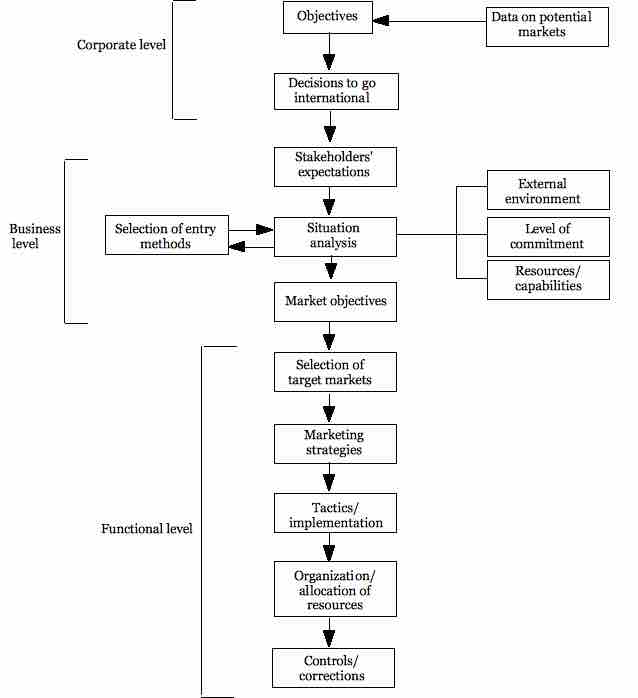U.S. firms choose to engage in international marketing for many reasons, the most attractive of which are market expansion and new profit opportunities. In general, the basic principles of domestic marketing can be applied to international marketing, but when attempting the latter, environmental factors in foreign countries must be taken into account. These include the (a) economic environment, (b) competitive environment, (c) cultural environment, (d) political/legal environment, (e) technological environment, and (f) ethical environment in foreign countries
There are five basic ways a firm can enter a foreign market, the selection of which depends largely on how much control a firm wishes to maintain over its marketing. When a firm chooses to market internationally, it must decide whether to adjust its domestic marketing program. Some firms customize their market programs, adjusting their marketing mix for each target market. Others use a standard marketing mix everywhere.
The Global Competitive Environment
U.S. companies must compete internationally with foreign marketers, who might have superior business strategies. Japanese companies, for example, have a method for designing products that is less wasteful than American strategies. Japanese companies typically begin a design process by determining what a market will be willing to pay for a product, and then advise their design teams to make a product based on this target cost. American companies, on the other hand, typically develop a product first, before determining whether a market can afford its cost.
The Types of International Exposure
Firms typically approach international marketing cautiously. For smaller firms in particular, exporting is often chosen over other strategies, because it offers a degree of control over risk, cost, and resource commitment. Smaller firms often only export in response to an unsolicited overseas order, which is perceived as low-risk.

The Decision Sequence in International Marketing
The challenge of international marketing is to ensure that any international strategy has the discipline of thorough research and an understanding and accurate evaluation of what is required to achieve competitive advantage. As such, the decision sequence in international marketing is much larger than that of domestic markets.
Exporting
Exporting is low-risk and is attractive for several reasons. First, products in the maturity stage of a domestic life-cycle might find new growth opportunities overseas. Second, some firms find it less risky and more profitable to export current products, instead of developing new products. Third, firms that face seasonal domestic demand might choose to market abroad in relation to these demands. Finally, some firms might export because there is less competition overseas.
Licensing/Franchising
Under a licensing agreement, a firm (licensor) provides a product to a foreign firm (licensee) by granting that firm the right to use the licensor's manufacturing process, brand name, patents, or sales knowledge, in return for payment. The licensee obtains a competitive advantage in this arrangement, while the licensor obtains inexpensive access to a new market. Scarce capital, import restrictions, or government restrictions often make this the only way a firm can market internationally. This method does contain some risks. It is typically the least profitable method for entering a foreign market, and it is a long-term commitment. Furthermore, if a licensee firm fails to successfully reproduce a particular product, it could tarnish that product's original brand image.
Joint Ventures
A joint venture is a partnership between a domestic and foreign firm. Both partners invest money, share ownership, and share control of the venture. Joint ventures require a greater commitment from firms than other methods, because they are riskier and less flexible.
Direct Investment
Multinational organizations may choose to engage in full-scale production and marketing abroad by directly investing in wholly-owned subsidiaries. As opposed to the previously mentioned methods of entry, this type of entry results in a company directly owning manufacturing or marketing subsidiaries overseas. This allows firms to compete more aggressively abroad, because they are literally "in" the marketplace. However, because the subsidiary is responsible for all the marketing activities in a foreign country, this method requires a much larger investment. This strategy is also risky, because it requires a complete understanding of business conditions and customs in a foreign country.
U.S. Commercial Centers
These centers provides resources to promote the export of U.S. goods and services abroad. The commercial center does this by familiarizing U.S. firms with industries, markets, and customs in other countries. U.S. commercial centers provide the following services: business facilities; translation and clerical services; a commercial library with legal information; and assistance with contracts and export/import arrangements. They also facilitate contacts between buyers, seller, bankers, distributors, and governmental officials.
Trade Intermediaries
If a small company lacks the resources or expertise to enter a foreign market, they can hire trade intermediaries, who do possess relationships in other countries. These entrepreneurial middlemen typically purchase U.S. produced goods at 15 per cent below a manufacturer's best discount, and then resell these products in overseas markets.
Alliances
In alliances, two or more separate entities jointly promote and sell a single concept, product, or service that is beneficial to all stakeholders. The stakeholders in such a case think a combined marketing approach will produce more significant results.